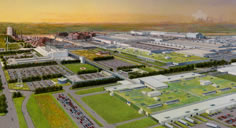Henry Ford had a vision of a "perfect" industrial complex, where raw materials could be processed, parts manufactured and products assembled, all in one place. The plant Ford built to realize this vision, the Rouge Assembly Plant, was the next step forward from the moving automotive assembly line that he had developed and fine-tuned at Highland Park.

End of an Era and Beginning of the Rouge
Even though the Rouge Assembly Plant was constructed over a period of years, production began in 1917, when a building was completed to allow the construction of 60 Eagle Boats for the U.S. Navy in World War I. By the mid-1920s, much of Ford’s vision was in place: The Rouge was processing its own materials, generating its own power and producing components for the Model T.
Most of the construction was completed by the 1940s, including miles of railroad tracks, the world's largest foundry and power plant, a sawmill and a glass plant. A web of raw- material conveyors and overpass walkways was constructed.
The Rouge’s Layout Improved Efficiency and Quality
Noted architect Albert Kahn designed most of the Rouge’s buildings, but it was Henry Ford and his team who carefully planned the facilities to maximize efficiency. Henry Ford was focused on achieving efficiency and quality throughout the complex, down to the smallest details.
From the beginning, Ford’s focus paid off in tremendously increased output. With 800 car bodies coming out of the Rouge every day as early as 1919, the company and the customers reaped the savings.
Efficiency Had Positive Environmental Impacts
Henry Ford's obsession with efficiency also had beneficial environmental and health impacts. Blast furnaces were unusually clean and waste-efficient. The ore dust they produced was captured and melted down for processing instead of flying out of the chimneys. Gases from coke ovens were trapped and reused for power.
The cleanliness of the Rouge’s steel operations was unprecedented and inspired similar changes throughout the steel industry. The focus on cleanliness extended to the entire complex. At the peak of the complex's employment, 5,000 of the 100,000 employees were assigned solely to keep the place clean, painted and well-maintained. All of this made for a workplace that was much cleaner and healthier than the average industrial setting of the 1930s and 1940s.
Memorable Vehicles Built at the Rouge
Over the years, many different products were built at the Rouge. After the Eagle Boats, Model T parts and bodies, as well as Fordson tractors, were produced, followed by the Model A, the famous V-8s of the 1930s, and other vehicles.
In the second half of the 20th century, the Rouge continued its steady output and turned out some of the company's most famous products, including luxury Lincolns for the 1945 model year, followed by the famous "Woodie" station wagons of the late 1940s and the iconic two-seater Thunderbird of 1954. Perhaps the most famous product to come out of the Rouge in this period was the Mustang.
Changes Ahead for the Rouge
As the industry trend toward decentralization took hold, things slowed down at the Rouge complex. But throughout the century and into the 21st, the company continued production at its Rouge facilities, even as a brand-new future was being planned.
Ford Motor Company employees were shaken and saddened in early 1999, when a tragic explosion at the Ford Rouge complex powerhouse killed six workers and injured others.
Revitalizing the Rouge for the 21st Century
As the 20th century was coming to an end, Ford Motor Company embarked on a $2 billion project to transform the 20th-century icon into a 21st-century manufacturing model. The revitalized complex, called the Ford Rouge Center, features lean, flexible and sustainable manufacturing processes, while honoring the site's past and enhancing the environment. It includes one of the world's largest living roofs, a 10.4-acre garden that is functional, economical and environmentally beneficial.
The Ford Rouge Center’s new Dearborn Truck Plant began producing the F-150 in 2004. The plant can handle three vehicle platforms and nine models on a single assembly line, providing flexibility in today's marketplace. The new Rouge Visitor Center offers a multimedia experience and a bird's-eye factory tour.
Rouge Timeline
- Construction of the Rouge complex began in January 1918.
- The first Ford tractor produced at the Rouge came off the line in February 1921.
- Public tours of the Rouge facilities began in 1924.
- Production of the new Model A began at the Rouge in 1927.
- Ford built its first G.P. (or "jeep") vehicle for the U.S. military at the Rouge in March 1941.
- Rouge Steel Company subsidiary was formed in 1981.
- In May 1984, Rouge Steel broke ground for a $145 million continuous-slab casting plant at the Rouge complex in Dearborn.
- In December 1989, Ford sold Rouge Steel Company, but retained 20 percent of the company (later also sold to Rouge Steel in 1992).
- In 1993, the company celebrated the 75th anniversary of the Rouge plant, now called Dearborn Assembly Plant.
- In 1999, an explosion at the Rouge powerhouse killed six employees and injured 24.
- In November 2000, Ford began redevelopment of the entire Ford Rouge Center, including a new vehicle assembly plant (Dearborn Truck Plant) as the centerpiece of the nation's largest industrial redevelopment project.
- In late 2002, Ford Rouge Center was designated an official wildlife habitat.
- Production of F-Series trucks began in 2004 at the new Dearborn Truck Plant at the Ford Rouge Center.



